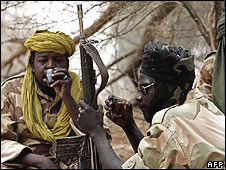|
When conflict broke out in Darfur early in 2003, there were just two major rebel groups. Since then, the insurgents have splintered into an array of competing factions, complicating already tense peace negotiations.
JEM
The Justice and Equality Movement (Jem) was founded by Darfuris drawn mostly from among former supporters of Islamist leader Hassan al-Turabi.

Jem fighters launched an attack on Khartoum in May 2008
|
He was a partner in President Omar al-Bashir's 1989 coup which overthrew Sadeq al-Mahdi's elected government. Jem is led by Khalil Ibrahim, a doctor who was one of the authors of "The Black Book", which documented the disproportionate power of three northern Arab tribes. Jem is currently the most significant fighting force in Darfur and in May 2008, the group launched an unprecedented attack on the Sudanese capital. Sudan's government has accused neighbouring Chad of arming Jem. Chadian President Idriss Deby is widely believed to have supported Jem because he is from the same Zaghawa ethnic group as Khalil Ibrahim. But last month Mr Deby visited Khartoum and both sides agreed to stop supporting each other's rebels. Following this - and a year of on-off negotiations in Qatar - the group is about to sign a ceasefire with Mr Bashir. According to the text of the accord, obtained by the BBC, Jem will constitute a political party after the signing of a final agreement, which Khartoum hopes will be before elections in April. Many Darfuris are said to distrust Dr Ibrahim because of his Islamist past and suspect he is focused on political power in Khartoum for his clan. Until he attacked the capital, Jem had limited support on the ground in Darfur.
SLA
With Jem, the Sudan Liberation Army (SLA) was one of the two original Darfur rebel groups, composed mainly of Fur, Zaghawa and Masalit - the three largest non-Arab tribes of Darfur. Existing divisions along largely ethnic lines widened, pitting Fur (led by Abdel Wahid Mohamed el-Nur) against Zaghawa (led by Minni Arkou Minnawi). SLA-Abdel Wahid Abdel Wahid has lived in self-imposed exile in Paris for several years.
His faction controls part of the central Jebel Marra mountain area and has wide support among Fur in Darfur's massive refugee camps. But it has been losing support as a result of Abdel Wahid's refusal to return to Darfur. There has been recent infighting among commanders in the Jebel Marra, some of whom want a change of direction in the movement. Mr Wahid insists on being the only rebel interlocutor and says he wants security in Darfur, including the disarmament of the Janjaweed militias, before peace talks. SLA-Minni faction Minnawi was the only rebel leader to sign the 2006 Darfur peace agreement (DPA) and was rewarded with the largely symbolic post of special adviser to President Bashir. His group had been losing ground before the DPA, and lost more after. His presence and power on the ground in Darfur today is minimal.
OTHER MOVEMENTS
Most other movements have been grouped together in two large and changeable bodies - the Tripoli group and the Addis Ababa group. The latter reportedly includes splinter SLM groups including SLM-Abdel Shafi and the United Resistance Movement of Bahar Idriss Abu Garda. He was accused of planning the killing of 12 African Union peacekeepers in 2007 and handed himself over to the International Criminal Court, but the case was dropped there was not enough evidence to proceed. According to Sudan's state news agency, the Tripoli and Addis Ababa groups have agreed to unite on the sidelines of the signing ceremony for the Jem ceasefire in Qatar, bringing together 10 Darfuri rebel movements.
|
Bookmark with:
What are these?